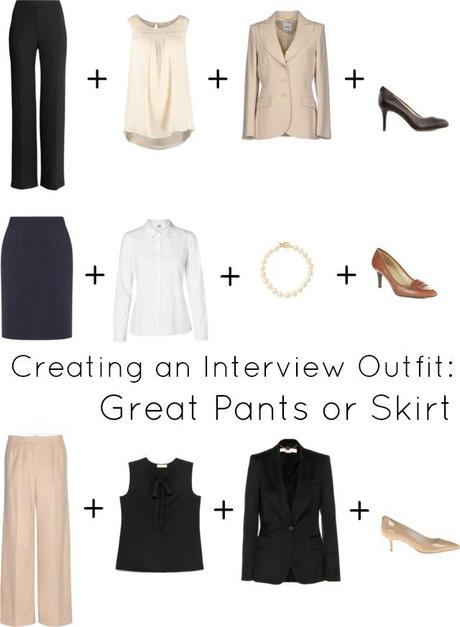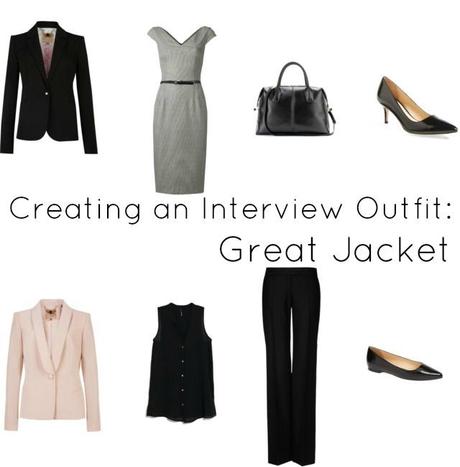I have decided to get a new job and find a healthier work environment. Thing is I don’t own a suit and I can’t spend more than $150 on interview clothes. Any suggestions on where to get a suit?
While you may luck out on the clearance rack of Ann Taylor or Banana Republic (and it can happen, I have a great matching blazer, pencil skirt and trousers from AT that cost under $200 thanks to coupons and clearance), you can’t guarantee that you’ll have success in time for your first interview. Some may recommend thrifting or consignment, but for an interview you need to put your best foot forward and again you can’t guarantee finding the right size and style in pristine quality in time.
I conduct interviews quite regularly at my job, for positions of all levels, and I have to say not wearing a suit is preferable to some cobbled together attempt at a jacket and trousers or skirt. It’s also preferable to wearing an obviously cheap suit. I’ve interviewed individuals with hems obviously stapled to the correct length, women in shiny tight Girls Night Out pants with a gabardine blazer, casual twill blazers with suiting trousers, tight thin knit skirts with a too-big power blazer clearly borrowed from Mom, and the cheap shiny hot pink pantsuit with beaded lapels and rhinestone buttons. Though these individuals strived to create a professional appearance, they focused too much on the need to create a suit than the need to create a polished, professional appearance.
So what do you do when you have limited time and funds but want to put your best foot forward for job interviews? Here’s some suggestions on how to create a professional look with few resources:
You Have Great Trousers (or a Great Skirt) but No Matching Suit Jacket
Great trousers means they fit – they don’t bag, they don’t hug your rear and thighs, they are the appropriate length (no ankle bone showing, no dragging on the ground). They are of a professional fabric (not shiny, not cotton twill, not stretchy), and likely lined to provide better drape and fit. These trousers are in a classic color – black, gray, brown, taupe, navy, possibly a dark muted green or wine.
A great skirt is a straight or pencil skirt that fits well, doesn’t ride up, doesn’t hug the rear, doesn’t wrinkle during a car or bus ride, hits the knees, and lets you walk a comfortable confident stride. It should be of a professional fabric and lined, free of embellishment and trendy details.
Pair with:
A crisp white shirt, necklace, and pumps. Purchase a wrinkle-resistant shirt that’s opaque and fits properly (no bulging buttons, not oversized, correct sleeve length), wear tucked into the trousers, and add a classic necklace that adds some shine. A pair of leather pumps in the same color as the trousers or skirt with an almond or pointed toe will look elegant, professional, and be a useful purchase after the interview.
A suiting blazer of the same fabric but different color and a blouse the same color as one or the other. Take your trousers shopping, or note the fabric composition on the tag and look for a jacket that is the same or extremely similar. However, don’t try to match grays or blacks because 99% of the time it won’t work and you’ll look sloppy. To get the most mileage of this jacket, choose one free of patterns and details, one that is a classic cut (no double breasted buttons, no cropped or perma-rolled sleeves, no creative collars), and in another neutral (black, gray, navy, taupe, ivory, cream).
By having your blouse (and with a mix like this I encourage a blouse, not a crisp shirt or a knit shell) either the same color as the jacket or the bottom, it creates cohesiveness and a purposeful look. Add interest with a necklace, belt (if applicable), and a confident smile.
If You Have a Great Jacket but No Trousers or Skirt
A great jacket means it fits GREAT, and to fit great it likely has been to the tailor. Sleeves the right length, shoulders in the right place, able to button without straining, not too tight but not oversized. The jacket is of a professional fabric (no twill, knit, denim, or anything with a shine), lined, and a classic cut. In this situation, a color is acceptable but it shouldn’t be too bold of a hue (bright yellow, lime green, orange, hot pink), or have trendy details (statement buttons, creative lapels, cut-outs, colorblocking or a print).
Pair with:
A suiting skirt or trousers and a blouse of the same color. Take the same advice above, and create a polished and cohesive look with a neutral blouse and trousers and a classic pair of pumps.
A professional tailored dress. This is not your pink floral rayon fit and flare frock, it’s not your striped ponte tee shirt dress, and it is never anything with spaghetti straps, cutouts (even if hidden under the jacket), or anything that is above the knee. Best choice is a sheath dress with a classic neckline (V, not too low scoop, crew or jewel neck), lined, and a fabric that coordinates with the jacket. Second choice is a dress that has a defined waist (self belt or banded waistband) and hits mid-knee to top of calf in a coordinating fabric. It’s important for this dress to have a tailored fit; a blazer over a loose dress will look sloppy and encourage creases.
Coordinating fabric means both of the same composition (see above), or fabrics that flatter one another (silk with crepe, wool with tweed, that sort of thing). If you’re not sure about coordinating fabrics I say to NOT go with this direction. It can be confusing, and too easy to go the wrong way.
If You Have Nothing and Need to Start From Scratch
Buy a Dress. Seriously, forgo the suit and get a professional dress in a solid color or subdued pattern. Pair with leather pumps in a neutral, wear a simple necklace, have polished hair and makeup and a nice bag and you will look far more competent and serious than in a hodgepodge of so-called professional attire.
No sheer portions or cutouts, no cleavage, no twee prints, trendy details, or overly vintage silhouettes. A sleeve is a very good idea, and the length should hit the knees. The style should skim the figure (more professional than a shift or sack dress), and be of a substantial fabric and/or lined. A few options under $150:
Do you have any suggestions for this reader?



